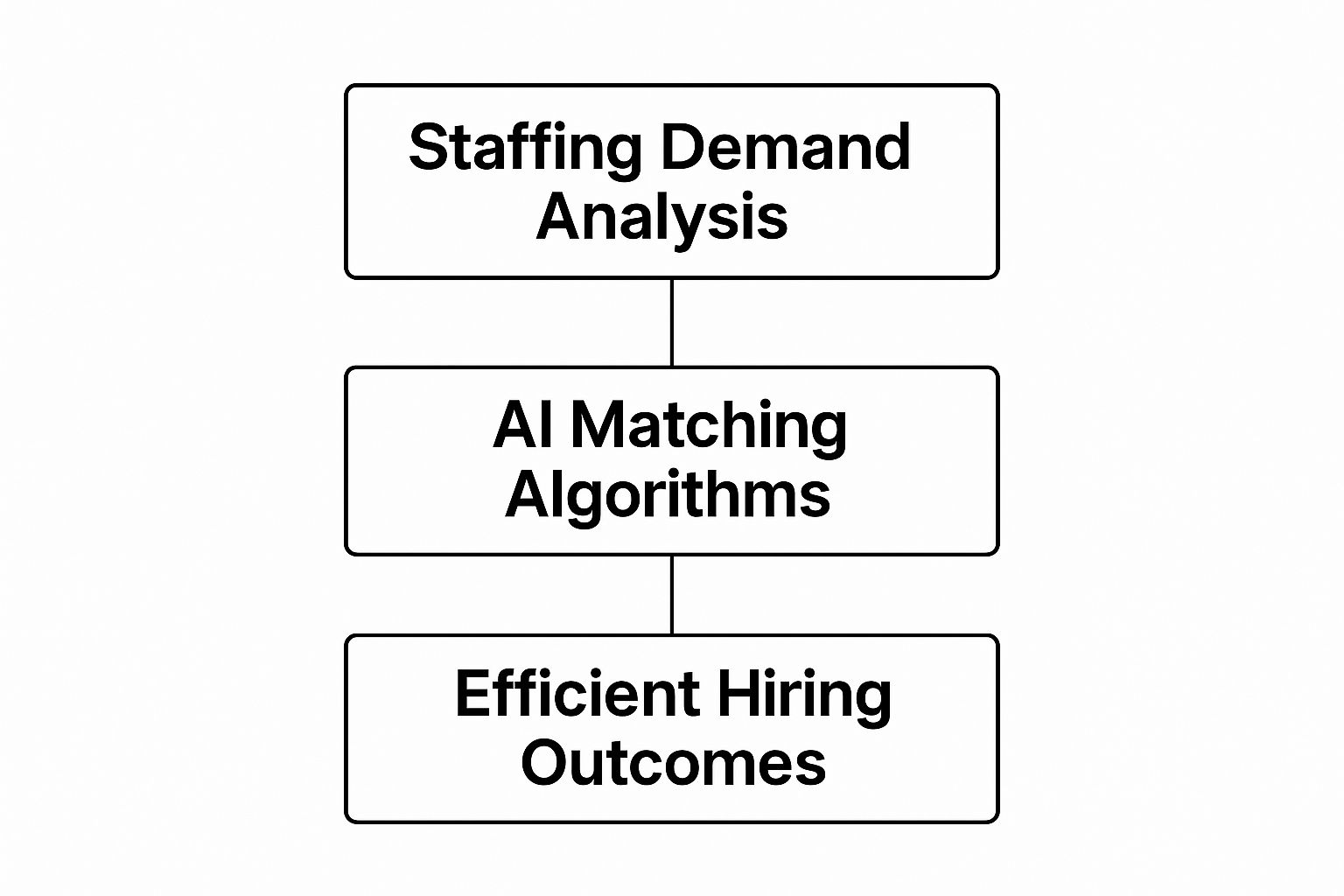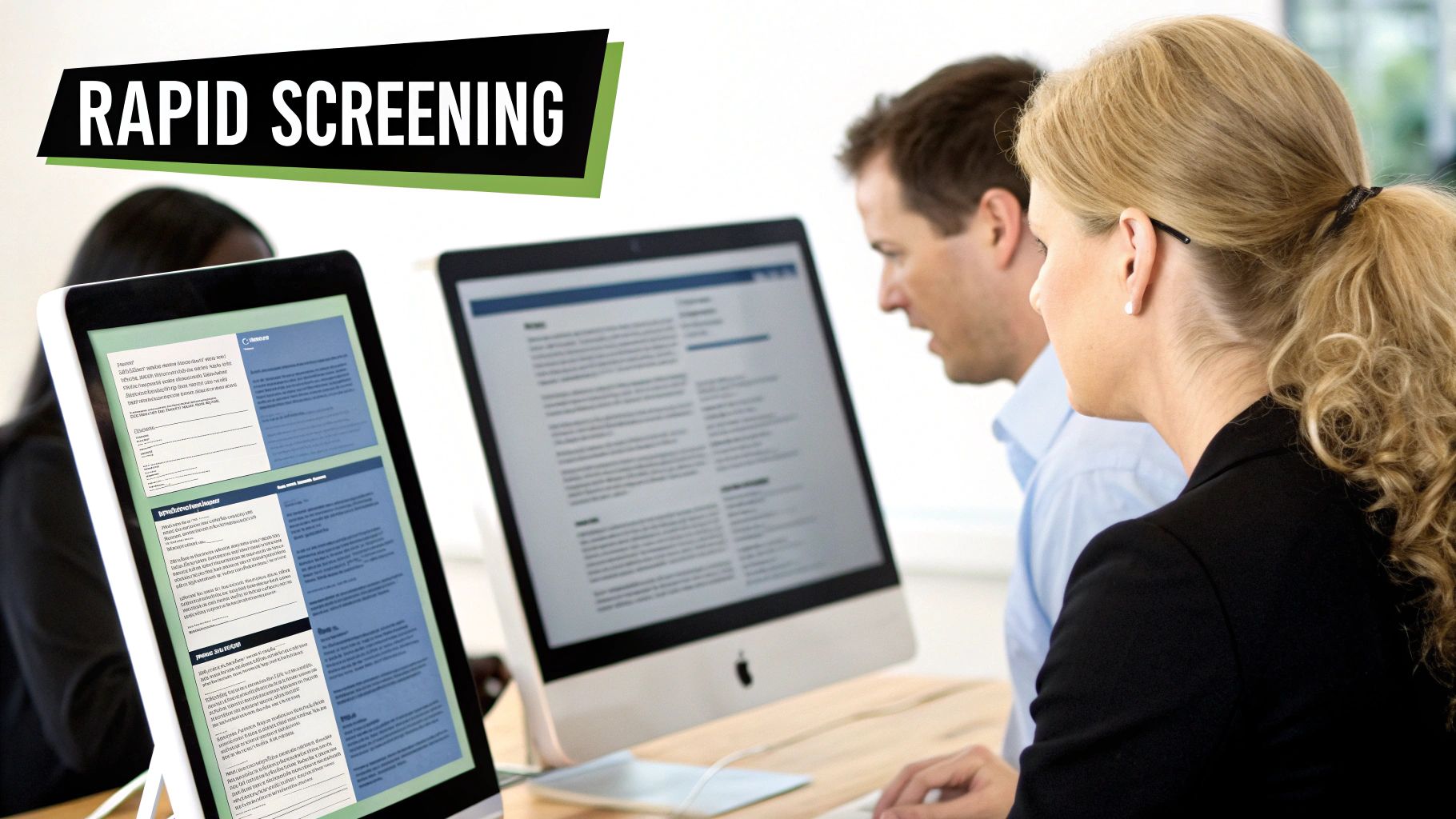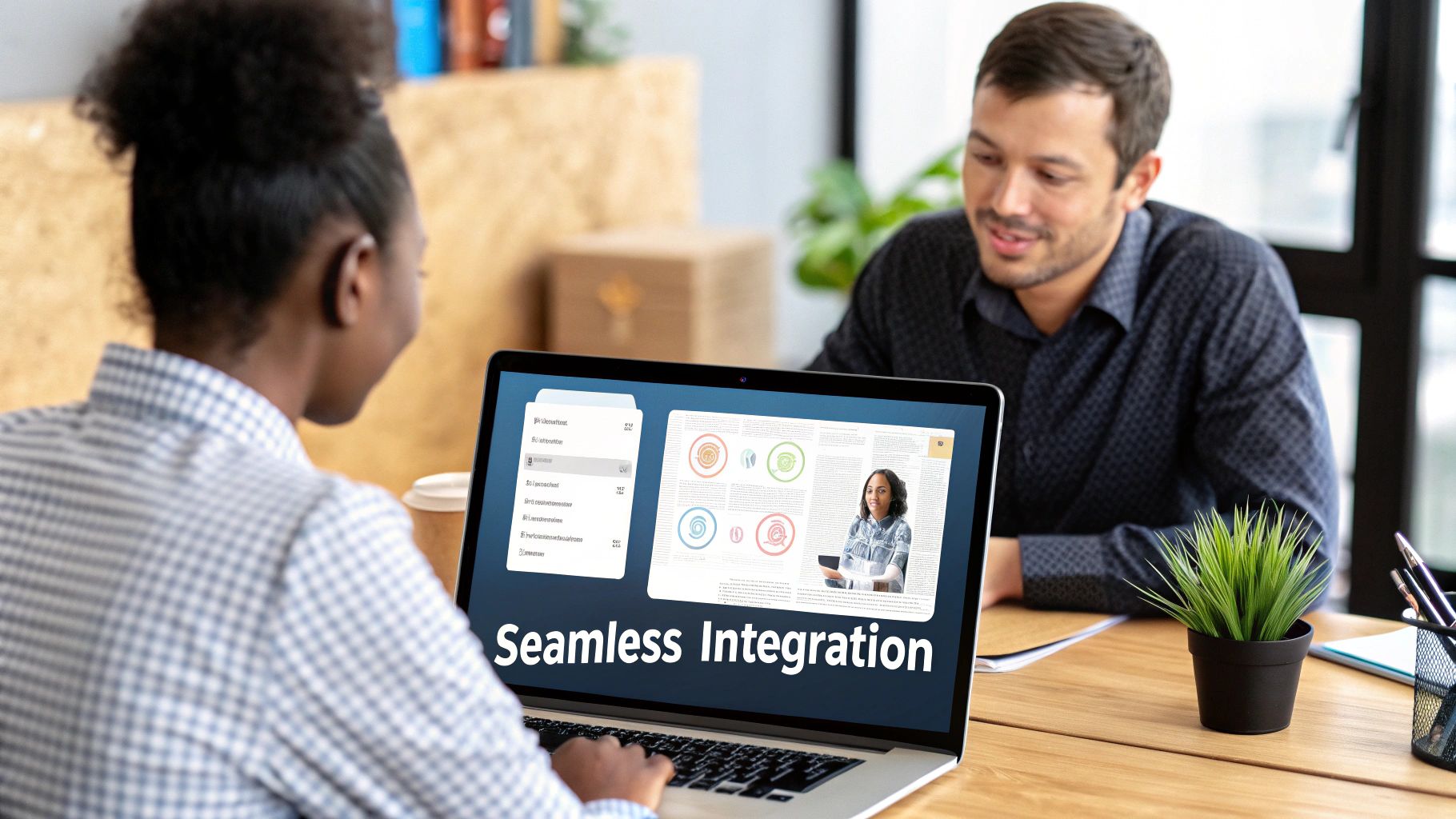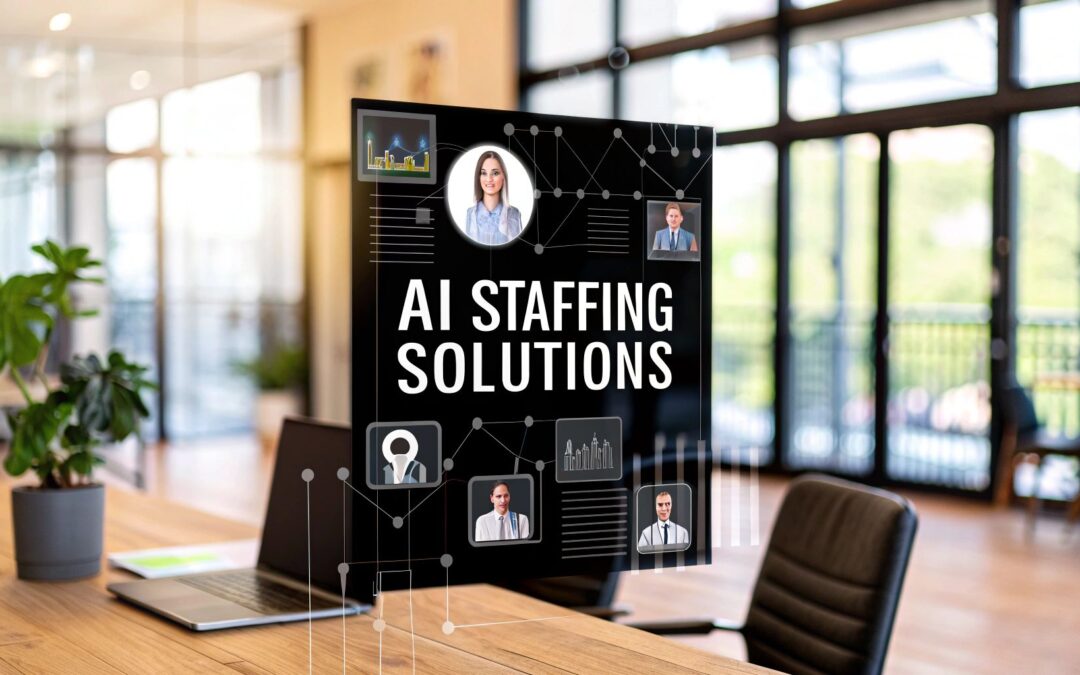Picture this: your hiring process is no longer a manual marathon of sifting through endless résumés. Instead, it’s a quick sprint that pinpoints the best talent in a fraction of the time. That’s the core promise of AI staffing solutions, which use intelligent technology to automate and fine-tune every part of the recruitment cycle. These platforms are built to make hiring faster, more precise, and far less biased.
What Are AI Staffing Solutions?
At its heart, an AI staffing solution is a sophisticated software platform that takes over the most time-consuming parts of finding new talent. If you think of a traditional recruiter as a librarian manually searching every single shelf for a specific book, an AI platform is like a smart digital catalog. It finds the perfect book—or in this case, the perfect candidate—in seconds by analyzing huge amounts of data.
This isn't about replacing recruiters. It's about giving them superpowers. The AI handles the heavy lifting of sourcing, screening, and initial outreach, freeing up recruiters to focus on what humans do best: building relationships and judging cultural fit. This collaboration creates a smarter, more effective hiring machine.
The Core Technologies at Play
Several key technologies work in concert to power modern AI staffing solutions. Getting to know these components helps pull back the curtain on how these platforms actually work.
Here’s a quick breakdown of the technologies that make it all possible.
Core Components of Modern AI Staffing Solutions
| AI Technology | Primary Function in Staffing | Key Benefit |
|---|---|---|
| Machine Learning (ML) | Learns from historical hiring data to identify patterns that signal a successful hire. | The system gets smarter over time, improving its ability to match the right person to the right role. |
| Natural Language Processing (NLP) | Understands and interprets human language from résumés, job descriptions, and chatbots. | Enables the AI to "read" and comprehend text, making initial screening and communication possible. |
| Predictive Analytics | Analyzes data from past successful hires to forecast which current applicants are most likely to excel. | Helps prioritize candidates who not only have the skills but also the traits for long-term retention. |
These technologies don't work in isolation; they combine to create a seamless and intelligent workflow.
This infographic gives you a great visual of how these pieces fit together to create a simple, effective hiring flow.

As the diagram shows, AI acts as the bridge between business needs and tangible results, using intelligent matching to drive more efficient hiring outcomes.
A Growing Market With Real Impact
It’s no surprise that companies are adopting these powerful tools at a rapid pace. This isn't just some passing trend; it’s a fundamental change in how modern teams are built.
The global AI recruitment market tells the story. Valued at roughly USD 596.16 million in 2025, it's on track to grow at a compound annual growth rate (CAGR) of 7.63%, reaching about USD 860.96 million by 2030. You can explore more about these market projections and see what's fueling this growth.
This expansion highlights a crucial reality: businesses are putting real money into technology to solve their biggest hiring headaches. The focus has shifted from simply filling seats to strategically building a high-performing workforce with data-backed precision. It's about creating measurable advantages, from slashing unconscious bias to drastically reducing the time it takes to hire.
The Business Impact of AI in Staffing

Bringing AI staffing solutions into your business isn't just about adding new software. It’s a fundamental strategic shift that delivers real, measurable results across the board. By taking over the repetitive, time-draining tasks, these platforms completely reshape how recruitment works, making a direct impact on your speed, quality of hire, and bottom line.
Think about your recruiters, currently swimming in a sea of résumés for just one open position. AI can dive into that sea and surface the best candidates in minutes, not days, by instantly matching them to your core needs. This frees up your team to do what they do best: build relationships, engage with top talent, and think strategically. The result is a much faster hiring process and a talent team that's always one step ahead.
Speeding Up the Hiring Cycle
In a tight talent market, speed is everything. The best candidates are often snapped up in a matter of weeks, and a slow, cumbersome hiring process means you’re losing out. This is a problem AI-powered automation was built to solve.
Here’s how AI puts hiring on the fast track:
- Automated Screening: AI algorithms can scan thousands of résumés against a job description in the blink of an eye, pinpointing qualified applicants with precision and consistency.
- Smart Scheduling: Instead of endless email back-and-forth, AI assistants and chatbots can coordinate interview times with candidates and hiring managers around the clock, sidestepping scheduling headaches entirely.
- 24/7 Candidate Engagement: Nearly 60% of job seekers are looking for roles outside of typical business hours. AI chatbots are there to greet them, answer their questions, and keep them engaged, so you never miss a connection.
This newfound speed isn't just for convenience—it's a serious competitive edge. When you can move faster, you secure top-tier talent before your competitors even get a chance to make an offer.
Improving Hiring Quality with Data
Beyond just being faster, AI staffing solutions help you hire smarter. It’s time to move past gut feelings and start using data to make confident, informed decisions. This is where predictive analytics really shines.
AI can analyze the profiles of your most successful current employees to identify the specific skills, experiences, and attributes that lead to long-term success at your company. This means the system doesn't just look for keywords on a résumé; it helps you find people who are genuinely a great fit for your culture and poised to thrive. This focus on data-driven decision-making in hiring helps you build stronger, more effective teams. You can dive deeper into this topic in our guide on data-driven decision-making.
Reducing Bias and Boosting Diversity
Let’s be honest: unconscious bias is a real and persistent problem in hiring. It often leads to teams that all look and think the same, which stifles innovation. AI provides a powerful way to level the playing field.
By programming an AI to ignore demographic details like names, ages, or schools during the initial screening, you can focus purely on objective, skills-based criteria. Every single applicant is measured against the exact same standard, giving everyone a fair shot. This objective approach naturally leads to a more diverse talent pipeline, which has been proven time and again to drive better business outcomes.
The industry is clearly taking notice. The artificial intelligence in HR market, which includes AI staffing solutions, was valued at USD 7.01 billion in 2024 and is on track to reach a staggering USD 30.77 billion by 2034. This kind of growth speaks volumes about the real-world value companies are getting. You can discover more insights about the global AI in HR market to see just how big this shift is.
How Different Industries Leverage AI Staffing

The true value of AI staffing solutions comes alive when you see them solving real problems on the ground. Hiring challenges aren't one-size-fits-all; what helps a tech startup isn't necessarily what a hospital or retail chain needs. Every industry grapples with its own unique pressures, from critical skill shortages and high turnover to the frantic rush of seasonal hiring.
This is where AI’s adaptability really makes a difference. Instead of a generic tool, it becomes a specialist, fine-tuned to tackle the specific hurdles each sector faces. Let's dig into how AI is making a real impact across a few key industries.
Healthcare: Speed and Precision
In healthcare, everything moves at high speed, and patient care hinges on having the right people in place. A delay in filling a critical nursing or technician role isn't just an inconvenience—it can have serious consequences. On top of that, the industry is bound by strict compliance, meaning every single hire requires meticulous verification of credentials and licenses.
This creates a perfect storm: the need to hire fast and the need to be incredibly accurate. Manual checks are slow and full of potential for human error, creating bottlenecks that healthcare providers simply can't afford.
This is where AI staffing solutions step in to directly address these pain points:
- Rapid Credential Verification: AI can instantly cross-reference licenses, certifications, and educational histories against official databases. A process that once took days is now done in minutes.
- Targeted Sourcing for Specialized Roles: Need a nurse with experience on a specific medical device? AI can pinpoint candidates with those niche clinical skills, ensuring a much better fit for highly specialized positions.
- Predictive Staffing for Demand Surges: By analyzing past patient data and seasonal health trends, AI helps hospitals anticipate when they'll need more staff, allowing them to build a pipeline before the rush hits.
Healthcare is currently the fastest-growing field for AI recruitment, with a projected CAGR of 13.30%. This boom is fueled by severe clinical staff shortages and the urgent need for the kind of automated, airtight credential checks that AI delivers so well. You can read the full analysis on AI recruitment market trends to see what’s driving this shift.
Technology and Engineering: Finding Niche Skills
The tech world is fiercely competitive. Companies are in a constant race to find developers, engineers, and data scientists who possess very specific, often brand-new skills. It’s not uncommon for a recruiter to get thousands of applications for a single software engineering role, with most being only vaguely qualified.
Trying to manually sift through that digital mountain to find a few genuine experts in a particular programming language or framework is a colossal waste of time.
AI completely rewrites the rules of this game. Using Natural Language Processing (NLP), these platforms can actually read and understand the technical details on a résumé or a GitHub profile. Instead of just matching keywords, the AI evaluates the context and quality of a candidate's experience. It effectively separates the true experts from the hobbyists, empowering tech companies to assemble elite teams faster than their competition.
Retail and Hospitality: Mastering High-Volume Hiring
Think about the holiday shopping season or the summer tourism rush. Industries like retail and hospitality depend on hiring massive numbers of seasonal or temporary workers to manage these peaks. For any HR team, bringing on hundreds or even thousands of people in a short window is a logistical nightmare.
The sheer volume of applications can easily swamp traditional hiring methods, causing delays and lost opportunities.
This is where AI-powered chatbots and automated systems shine. They can:
- Engage Applicants 24/7: A chatbot is always on, ready to interact with candidates, answer common questions, and guide them through the first steps of an application, no matter the time of day.
- Conduct Initial Screenings: The AI can ask basic qualifying questions about availability, work eligibility, and other must-haves, instantly filtering the applicant pool.
- Automate Interview Scheduling: Once a candidate passes the initial screen, the system can automatically schedule an interview with a hiring manager, cutting out all the administrative back-and-forth.
This level of automation allows businesses to scale their hiring up or down with incredible speed, ensuring they’re always staffed to meet demand without burning out their core HR team.
Choosing the Right AI Staffing Partner

Picking the right AI staffing solutions partner is a big deal. It’s a decision that will shape your recruiting strategy for years to come. Think of it less like buying a piece of software and more like entering a strategic partnership that needs to align perfectly with your hiring goals. With so many options out there, the real challenge is finding the one that fits your business like a glove.
Before you even think about watching a demo, the most important step is to look inward. A smart choice starts with a crystal-clear understanding of the specific problems you need AI to solve. Are your recruiters drowning in a sea of unqualified resumes? Is your time-to-hire lagging way behind the competition? Are you struggling to unearth candidates with those rare, niche skills?
Nailing down these pain points gives you a roadmap. It helps you see past flashy features and zero in on the capabilities that will actually deliver a return on your investment. Once you know your "why," you can set clear, measurable goals. For example, you might aim to "cut our time-to-hire by 30%" or "boost the diversity of our candidate pipeline by 25% within the next year."
Evaluating Core Platform Capabilities
With your goals in hand, it's time to start sizing up potential partners. Every AI platform will promise to find you the best talent, but the how is what really separates the great from the good. You have to peek under the hood and understand the engine that powers their recommendations.
One of the first things to dig into is the sophistication of their matching algorithms. Don't be afraid to ask vendors how their tech moves beyond simple keyword matching. Does it understand the context of a candidate's experience? Can it infer skills that aren't even on the resume? The best platforms use a blend of technologies to paint a full picture of every person in your talent pool.
Next up is the user experience—both for your recruiters and for the candidates themselves. A powerful tool is worthless if your team finds it clunky or confusing. A clean, intuitive interface is key to getting everyone on board and making sure they can leverage the system's full potential. At the end of the day, the platform should make their lives easier, not add another layer of complexity to their workflow.
A great AI staffing partner doesn't just automate tasks; it provides a more intelligent way to work. The platform should feel like a natural extension of your recruitment team, offering insights and efficiencies that were previously out of reach.
Focusing on Integration and Security
Even the smartest AI tool is a dead end if it can't talk to your other systems. Seamless integration with your existing HR tech stack isn't a "nice-to-have"—it's a must. Your chosen AI staffing solution has to connect smoothly with your Applicant Tracking System (ATS), HRIS, and any other platforms your team uses daily. This creates a single source of truth and saves everyone from the headache of manual data entry.
Just as critical are data security and compliance. You're about to trust a vendor with highly sensitive candidate and company information, so you have to be confident in their security protocols. Make sure they comply with all the data protection rules that apply to you, whether that's GDPR in Europe or CCPA in California.
On top of that, ethical AI is no longer just a buzzword; it's a business imperative. The best vendors are actively working to minimize algorithmic bias, often including features like bias detection dashboards and transparent audit trails. This commitment to ethical governance is a tell-tale sign of a mature, responsible partner. You can learn more about AI recruitment market trends to see just how much responsible AI is shaping the industry.
Vendor Evaluation Checklist for AI Staffing Solutions
Choosing a vendor can feel overwhelming, so a structured approach is your best friend. This checklist is designed to help you compare potential partners side-by-side, ensuring you cover all the critical bases before making a final decision.
| Evaluation Criteria | Vendor A | Vendor B | Vendor C (e.g., Zilo AI) |
|---|---|---|---|
| Technology & Algorithms | |||
| Matching accuracy and sophistication | |||
| Bias detection and mitigation features | |||
| Quality of the candidate pool | |||
| Integration & Compatibility | |||
| Seamless ATS/HRIS integration | |||
| Ease of implementation process | |||
| User Experience (UX) | |||
| Intuitive recruiter interface | |||
| Positive candidate experience | |||
| Security & Compliance | |||
| GDPR/CCPA/other compliance | |||
| Data encryption and security protocols | |||
| Support & Partnership | |||
| Quality of training and onboarding | |||
| Ongoing customer support and CSM | |||
| Product roadmap and innovation |
By systematically filling out this checklist during your demos and conversations, you'll get a much clearer picture of which provider truly aligns with your needs and which one is just offering empty promises.
Key Questions to Ask Potential Vendors
To make a truly informed decision, you need to ask sharp, specific questions. Here’s a quick list to get you started during your vendor calls:
- Integration: How does your platform integrate with our current ATS? Walk me through the typical implementation process.
- Algorithm: Can you explain how your matching algorithm works? What steps do you take to ensure it reduces bias?
- Data Security: What specific measures do you have in place to protect our data? Can you confirm you're compliant with GDPR/CCPA?
- Support: What kind of training and ongoing support do you offer our recruitment team once we're live?
- Roadmap: What new features or improvements are on your product roadmap for the next 12 months?
By thoroughly vetting each potential partner against your unique needs and these critical questions, you can confidently choose an AI staffing solution like Zilo AI that solves today’s challenges and helps you build a more strategic and successful talent engine for the future.
Making a Smooth Switch to AI
Rolling out an AI staffing solution successfully is about people, not just software. It’s a genuine change management challenge, and without a solid plan, clear communication, and buy-in from your entire team, you're setting yourself up for failure. Just dropping a new platform on your team without a thoughtful strategy often leads to confusion and low adoption, killing its potential before it even gets started. A smooth transition makes your team feel empowered by their new tools, not threatened by them.
The journey starts with laying the technical groundwork. The first, most critical step is moving your existing candidate data and job descriptions into the new system. You absolutely have to maintain data integrity during this migration. Why? Because the AI’s performance is a direct reflection of the quality of the information you feed it. Think of it this way: clean, well-organized data is the high-octane fuel that powers accurate candidate matching and sharp predictive insights.
Moving to an AI-powered system is a fundamentally human effort. The real goal isn't just to install software; it's to elevate how your team operates. Success hinges on building genuine excitement and skill, turning your recruiters into strategic advisors who are masters of their new AI-powered tools.
Getting Your Team On Board
Once the system is set up and ready to go, your focus has to shift completely to your people. Your recruiters are on the front lines, and their excitement—or lack thereof—will make or break this implementation. It's essential to get them genuinely enthusiastic about the benefits of their new AI assistant.
Don't just introduce it as another tool they have to learn. Frame it as the solution to their biggest headaches. Show them exactly how the AI will take over the mind-numbing, administrative work—like sifting through mountains of unqualified resumes—that eats up their time and energy. This isn't about replacing them; it's about freeing them up to do what they do best: build relationships, gauge cultural fit, and close fantastic candidates.
- Hands-On Training: Run comprehensive training sessions tailored to specific roles. Go beyond a simple feature tour and let them see for themselves how the platform tackles real-world recruiting challenges.
- Create AI Champions: Pinpoint the early adopters on your team who are naturally excited by the technology. Turn them into internal champions who can support their colleagues and share wins.
- Establish a Feedback Loop: Set up a straightforward way for recruiters to share feedback, ask questions, and flag problems. When you act on their input, it proves you value their expertise and are committed to making the tool work for them.
Launching a Pilot Program for a Strong Start
Before you go all-in with a company-wide deployment, running a pilot program is a brilliant move. Think of it as a controlled test flight. A pilot lets a small, focused team use the AI staffing solution in a live environment, giving you a safe space to iron out any wrinkles.
This approach has some huge benefits. It helps you catch any unexpected technical glitches or workflow snags on a much smaller, more manageable scale. Plus, the feedback you get from this pilot group is pure gold for refining your training materials and full rollout plan. For more ideas on refining workflows, take a look at our guide on business process automation.
To know if your pilot is working, you need to set clear Key Performance Indicators (KPIs) right from the beginning.
Key Pilot Program KPIs:
- Time-to-Fill: How much faster is the pilot team filling roles compared to your old methods?
- Quality of Hire: After 90 days, how are the candidates hired through the AI platform performing?
- Recruiter Adoption Rate: How often is the pilot team actually using the platform and its most important features?
- Candidate Experience: What do candidates think? Survey those who interacted with the AI to check their satisfaction levels.
When you can prove the AI's value with hard data from a successful pilot, you create powerful momentum that gets every stakeholder excited and ready for a full-scale launch.
The Future of AI and Human Collaboration in Hiring
The growing presence of AI in recruitment doesn't mean we're heading toward a future where machines make all the hiring calls. Not at all. It actually signals a powerful move toward a hybrid model where artificial intelligence and human intuition work in tandem. The goal isn't to push people out of the equation but to forge a more effective, human-focused partnership.
Think of AI as the ultimate co-pilot for your talent team. It can expertly navigate the data-heavy, repetitive tasks that often bog recruiters down—like sifting through thousands of resumes or coordinating complex interview schedules. By taking on this administrative load, AI gives your human experts the freedom to concentrate on what they truly excel at.
This paves the way for a hiring process that isn't just faster, but fundamentally fairer and more insightful.
Empowering Strategic Talent Advisors
When recruiters are freed from the mountain of administrative work, their roles naturally evolve. They shift from being task managers to becoming strategic talent advisors. Their time gets poured back into high-impact activities that a machine simply can't perform.
These are the uniquely human skills that make all the difference:
- Deep Cultural Assessment: Gauging whether a candidate’s personality and work style truly mesh with the company’s environment.
- Complex Negotiation: Understanding a candidate's personal motivations to build an offer that’s compelling beyond just the salary.
- Building Genuine Relationships: Establishing the kind of trust and rapport that convinces A-list talent to come aboard.
- Mentorship and Guidance: Acting as a supportive guide and providing real career advice throughout the entire hiring journey.
The most effective recruitment models will always blend AI's raw efficiency in processing data with the uniquely human skills of empathy, strategic thinking, and cultural intuition. This synergy creates a hiring process that is both incredibly intelligent and deeply personal.
The future of hiring will hinge on striking this balance between human expertise and AI-driven efficiency. This shift mirrors a broader trend where AI is moving from a niche technology to a core operational tool.
A More Human-Centric Future
At the end of the day, the best AI staffing solutions are designed to amplify human abilities, not replace them. They deliver the data and insights needed to make smarter, less biased decisions while carving out more time for recruiters to have meaningful conversations. This combination leads to better results for everyone. For a fascinating look at how accessible tech can spur innovation, check out our guide on low-code and no-code AI platforms.
By letting AI handle the mechanics, we empower our teams to focus on the humanity at the heart of hiring. This creates a future that's faster, fairer, and more effective than ever before.
Frequently Asked Questions
When you start exploring AI staffing solutions, a lot of good questions naturally come up. It's smart to get a handle on the details so you can see exactly how this kind of technology could fit into your company. Let's walk through some of the most common things people ask.
Will AI Staffing Solutions Replace Human Recruiters?
Not at all. Think of AI as a powerful assistant for your recruiting team, not a replacement. The real goal is to empower recruiters by taking over the tedious, high-volume tasks that eat up their day—things like sifting through hundreds of résumés or scheduling first-round interviews.
This frees them up to do what humans do best: build genuine relationships with promising candidates, dive deep into final interviews, and really gauge things like cultural fit and long-term potential. The best results happen when AI handles the data and logistics, leaving your team to focus on the human side of hiring—empathy, negotiation, and strategic thinking.
How Do AI Staffing Solutions Help Reduce Hiring Bias?
This is one of the most significant benefits. A well-built AI platform can be a game-changer for fairness by sticking strictly to objective, skill-based criteria. You can configure it to completely ignore demographic details like names, ages, or gender during the initial screening.
The system evaluates every single applicant against the same standardized qualifications outlined in the job description. This creates a much more level playing field from the very beginning.
By focusing purely on objective metrics, you’re taking a huge step toward building a more diverse, qualified, and innovative team. The best platforms even come with features that actively detect potential bias and provide audit trails to keep everything transparent and fair.
Is Implementing an AI Staffing Solution Expensive?
The cost can vary, but it's probably more accessible than you think. Many of the top AI staffing solutions are offered as cloud-based services (SaaS), which means you don't have a massive upfront hardware or software investment. They're built to plug right into the HR tools you already use, like your Applicant Tracking System (ATS).
Sure, there's a cost for the service and some time for training, but the return on that investment is usually pretty clear. You'll see it in a faster hiring process, lower recruiting costs, and a noticeable jump in the quality of your hires. Most providers have different pricing tiers to match the budgets and needs of different-sized companies.
What Data Does an AI Staffing Solution Need to Work?
For an AI to deliver great results, it needs great data to learn from. It’s a classic "garbage in, garbage out" situation. There are two key ingredients:
- Detailed Job Descriptions: These need to be specific and clear about the skills required, moving past generic buzzwords.
- A Pool of Candidate Data: This is your collection of résumés and applications that the AI will analyze to find the best matches.
Past hiring data is also incredibly valuable. It helps the AI learn what a successful employee looks like at your company. The cleaner and more relevant your data is, the smarter and more accurate the AI will be at finding the right people for you.
Ready to see how the right partner can reshape your hiring and data strategy? Zilo AI offers everything from expert manpower services to AI-ready data solutions designed to help you grow. Learn more about our end-to-end solutions at Zilo Services.

